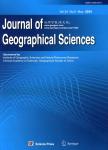Mapping runoff based on hydro-stochastic approach for the Huaihe River Basin, China
Mapping runoff based on hydro-stochastic approach for the Huaihe River Basin, China作者机构:Institute of Geographic Sciences and Natural Resources Research CAS Beijing 100101 China Graduate University of Chinese Academy of Sciences Beijing 100049 China Department of Geosciences University of Oslo N-0315 Oslo Norway
出 版 物:《Journal of Geographical Sciences》 (地理学报(英文版))
年 卷 期:2011年第21卷第3期
页 面:441-457页
核心收录:
学科分类:0711[理学-系统科学] 07[理学] 08[工学] 081501[工学-水文学及水资源] 0815[工学-水利工程] 071101[理学-系统理论]
基 金:National Basic Research Program of China, No.2010CB428406 Key Project of the National Natural Science Foundation of China, No.40730632
主 题:kriging method hydro-stochastic runoff water balance Huaihe River Basin
摘 要:Theoretical difficulties for mapping and for estimating river regime characteristics in a large-scale basin remain because of the nature of the variable under study: river flows are related to a specific area, i.e. the drainage basin, and are hierarchically organized in space through the river network with upstream-downstream dependencies. Another limitation is there are not enough gauge stations in developing countries. This presentation aims at developing the hydro-stochastic approach for producing choropleth maps of average annual runoff and computing mean discharge along the main river network for a large-scale basin. The approach applied to mean annual runoff is based on geostatistical interpolation proce- dures coupled with water balance and data uncertainty analyses. It is proved by an applica- tion in the upstream at Bengbu in the Huaihe River Basin, a typical large-scale basin in China. Hydro-stochasitic approach in a first step interpolates to a regular grid net and in a second step the grid values are integrated along rivers, The interpolation scheme includes a constraint to be able to account for the lateral water balance along the rivers. Grid runoff map with 10 km x 10 km resolution and the discharge map along the river with the 1 km basic length unit are the main results in this study. This kind of statistic approach can be widely used because it avoids the complexity of hydrological models and does not depend on the meteorological data.



